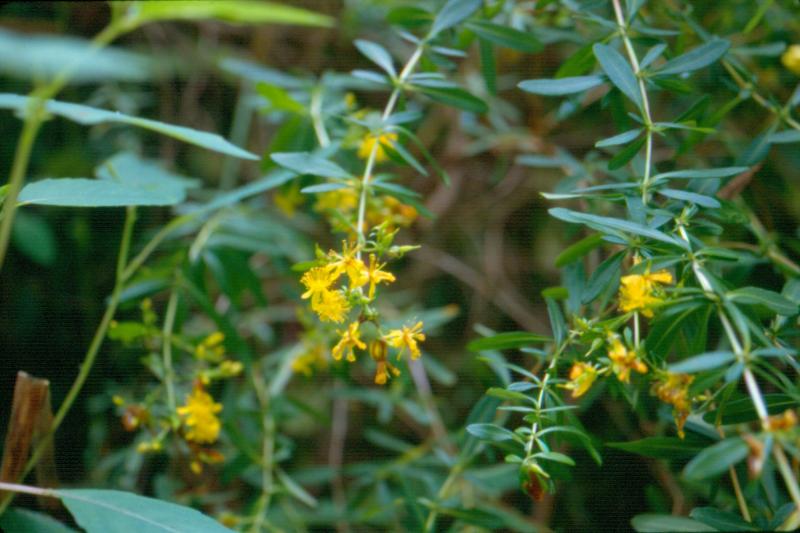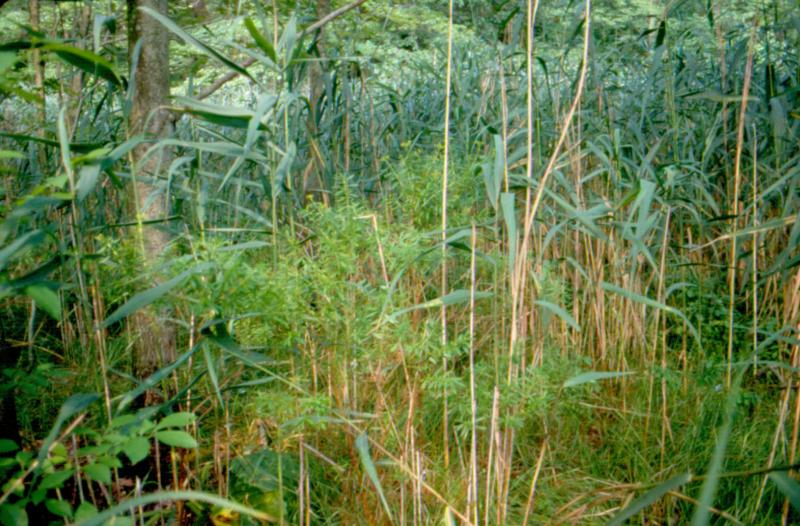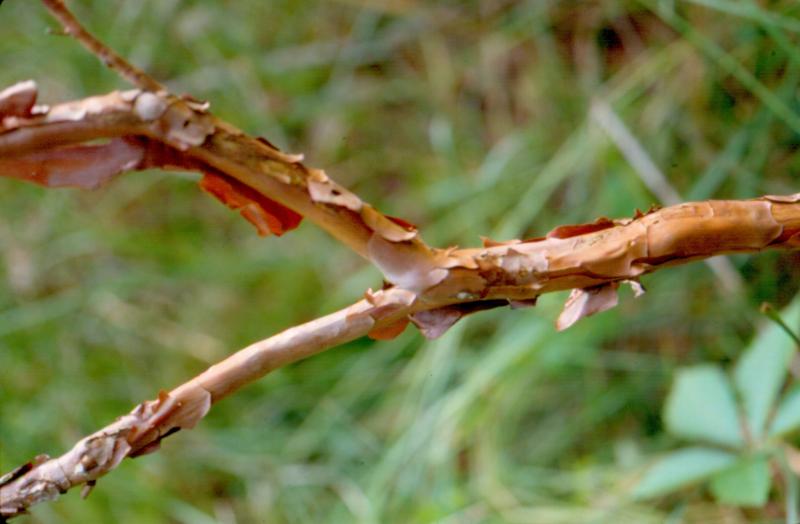Bushy St. John's Wort
Hypericum densiflorum Pursh
- Class
- Dicotyledoneae (Dicots)
- Family
- Hypericaceae
- State Protection
- Endangered
Listed as Endangered by New York State: in imminent danger of extirpation in New York. For animals, taking, importation, transportation, or possession is prohibited, except under license or permit. For plants, removal or damage without the consent of the landowner is prohibited.
- Federal Protection
- Not Listed
- State Conservation Status Rank
- S1
Critically Imperiled in New York - Especially vulnerable to disappearing from New York due to extreme rarity or other factors; typically 5 or fewer populations or locations in New York, very few individuals, very restricted range, very few remaining acres (or miles of stream), and/or very steep declines.
- Global Conservation Status Rank
- G5
Secure globally - Common in the world; widespread and abundant (but may be rare in some parts of its range).
Summary
Did you know?
This species was introduced into the horticulture trade in the US in 1899 (Dirr 1975) but was found in Long Island pine barrens as far back as 1884. Even though the only remaining population occurs in a natural area near large houses where it could have escaped from garden plantings, it could also be a relic from native populations.
State Ranking Justification
There is one small existing population that is currently threatened by Phragmites. Two records from the turn of the 20th century from Western Long Island are now considered gone because their habitat has been destroyed but there's still a chance that one population that was documented in 1916 in Babylon may still be present.
Short-term Trends
Plant numbers have ranged from six to 300 depending upon water levels so it is difficult to tell what the actual short-term trend is.
Long-term Trends
Long-term trends are negative as known populations have been reduced from three to one.
Conservation and Management
Threats
Phragmites is crowding out and shading the plants.
Conservation Strategies and Management Practices
The pondshore needs to be protected from direct disturbance by ATVs and excessive trampling. Phragmites must be prevented from expanding and the current population must be eliminated. A natural buffer of at least 200 feet should be established around the ponds to prevent excessive runoff and pollution events.
Research Needs
Research is needed into methods to successfully propagate this plant so the population can be augmented at its present site.
Habitat
Habitat
The plants occur in a red maple swamp that has colonized the remains of an old pond after the dam broke (New York Natural Heritage Program 2012). Wet meadows and moist bottomlands, less often on rocky slopes (Gleason and Cronquist 1991). Swamps and wet acid soil (Fernald 1950).
Associated Ecological Communities
- Red maple-hardwood swamp
(guide)
A hardwood swamp that occurs in poorly drained depressions, usually on inorganic soils. Red maple is usually the most abundant canopy tree, but it can also be codominant with white, green, or black ash; white or slippery elm; yellow birch; and swamp white oak.
Associated Species
- Carex lurida (sallow sedge)
- Carex stricta (tussock sedge)
- Phragmites australis (old world reed grass, old world phragmites)
Range
New York State Distribution
This shrub was known historically from one location in Nassau County and one location from Suffolk County on Long Island. It was discovered in a third locality in western Suffolk County in 1986.
Global Distribution
This is primarily a species of the Atlantic coastal plain from Long Island to South Carolina and the Appalachian Mountain chain from Pennsylvania southwest to Alabama.
Identification Comments
General Description
This plant is a much-branched shrub about 2-3 meters tall. Leaves are narrow and usually wider towards the tip, 2-4 centimeters long and 5-8 millimeters wide. There are 7-many flowers in a large inflorescence that appears leafy. Each flower has 3 styles and five bright yellow petals around many long yellow stamens. The fruit is a capsule up to 6 millimeters long and 3 millimeters wide. The placentas intrude into the fruit but do not meet in the center.
Best Life Stage for Proper Identification
The best time to identify this shrub is when it is in flower or fruit.
Similar Species
Shrubby St. John's-wort, Hypericum prolificum, can look similar but there are only 3-7 flowers in its inflorescence and the fruit is larger, 7 mm long by 3.5 mm wide.
Best Time to See
The leaves come out in April or May and it flowers in late July through August. The fruits are visible in September and October.
- Vegetative
- Flowering
- Fruiting
The time of year you would expect to find Bushy St. John's Wort vegetative, flowering, and fruiting in New York.
Bushy St. John's Wort Images
Taxonomy
Bushy St. John's Wort
Hypericum densiflorum Pursh
- Kingdom Plantae
- Phylum Anthophyta
- Class Dicotyledoneae
(Dicots)
- Order Malpighiales
- Family Hypericaceae
- Order Malpighiales
- Class Dicotyledoneae
(Dicots)
- Phylum Anthophyta
Additional Resources
Best Identification Reference
Gleason, Henry A. and A. Cronquist. 1991. Manual of Vascular Plants of Northeastern United States and Adjacent Canada. The New York Botanical Garden, Bronx, New York. 910 pp.
Other References
Clemants, Steven and Carol Gracie. 2006. Wildflowers in the Field and Forest. A Field Guide to the Northeastern United States. Oxford University Press, New York, NY. 445 pp.
Crow, Garrett E. and C. Barre Hellquist. 2000. Aquatic and Wetland Plants of Northeastern North America: A revised and enlarged edition of Norman C. Fassett's a Manual of Aquatic Plants. Volume One: Pteridophytes, Gymnosperms, and Angiosperms: Dicotyledons. The University of Wisconsin Press. Madison, Wisconsin. 536 Pages.
Dirr, M.A. 1990. Manual of Woody Landscape Plants. Stipes Publishing Company, Champaign, Illinois. 1007 pp.
Fernald, M.L. 1950. Gray's manual of botany. 8th edition. D. Van Nostrand, New York. 1632 pp.
Holmgren, Noel. 1998. The Illustrated Companion to Gleason and Cronquist's Manual. Illustrations of the Vascular Plants of Northeastern United States and Adjacent Canada. The New York Botanical Garden, Bronx, New York.
New York Natural Heritage Program. 2010. Biotics database. New York Natural Heritage Program. New York State Department of Environmental Conservation. Albany, NY.
New York Natural Heritage Program. 2024. New York Natural Heritage Program Databases. Albany, NY.
Weldy, T. and D. Werier. 2010. New York flora atlas. [S.M. Landry, K.N. Campbell, and L.D. Mabe (original application development), Florida Center for Community Design and Research http://www.fccdr.usf.edu/. University of South Florida http://www.usf.edu/]. New York Flora Association http://newyork.plantatlas.usf.edu/, Albany, New York
Links
About This Guide
This guide was authored by: Stephen M. Young
Information for this guide was last updated on: September 20, 2012
Please cite this page as:
New York Natural Heritage Program. 2024.
Online Conservation Guide for
Hypericum densiflorum.
Available from: https://guides.nynhp.org/bushy-st-johns-wort/.
Accessed July 27, 2024.


